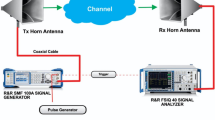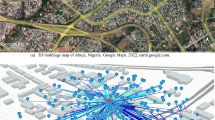Abstract
Within studies focused on channel modeling for 5G priority bands and indoor environments, this work aims at several large-scale channel modeling and statistical analysis regarding electromagnetic waves’ behavior within corridors to better understand the channels’ behavior. We studied five corridors with a difference in morphologies and dielectric materials. Choosing the large-scale path loss models, close-in free space reference, and floating intercept due to their high usability in the literature. The PLE, FSPL alpha, and beta parameters were determined using the minimum mean square error. We also considered the standard deviation point-to-point and standard deviation representing the random variable on the measured data for the statistical approach.









Similar content being viewed by others
References
Ni, Y., Liang, J., Shi, X. & Ban, D. (2019). Research on key technology in 5G mobile communication network. In 2019 International Conference on Intelligent Transportation, Big Data & Smart City (ICITBS), Changsha, China, 2019 (pp. 199-201).
Fundamentals of 5G Mobile Networks, John Wiley & Sons, United Kingdom (2015).
Rappaport, T. S., Xing, Y., MacCartney, G. R., Molisch, A. F., Mellios, E., & Zhang, J. (2017). Overview of millimeter wave communications for fifth-generation (5G) wireless networks-with a focus on propagation models. IEEE Transactions on Antennas and Propagation, 65(12), 6213–6230.
Roh, W., et al. (2014). Millimeter-wave beamforming as an enabling technology for 5G cellular communications: theoretical feasibility and prototype results. IEEE Communications Magazine, 52(2), 106–113.
Elkashlan, M. T., Duong, Q., & Chen, H. (2016). Millimeter-wave communications for 5G: fundamentals: Part I [Guest Editorial]. IEEE Communications Surveys & Tutorials, 18(2), 1018–1044.
Elkashlan, M. T., Duong, Q., & Chen, H. (2015). Millimeter-wave communications for 5G - Part 2: applications [Guest Editorial]. IEEE Communications Magazine, 53(1), 166–167.
Tetsuro, I. et al. Radio Propagation for 5G. In NTT DOCOMO Technical Journal, 2016. [Online]. https://www.nttdocomo.co.jp/english/binary/pdf/corporate/technology/rd/technical_journal/bn/vol17_4/vol17_4_005en.pdf.
Mobile and Wireless Communications Enablers for the Twenty-twenty Information Society (METIS): METIS Channel Models,[Online]. July 2017. https://www.metis2020.com/wp-content/uploads/METIS_D1.4_v3.pdf.
3GPP: “Channel modeling for higher frequency bands,” RP151306, Jun. 14-16 (2015).
Use of Spectrum Bands Above 24 GHz For Mobile Radio Services, et al, (2018). [Online]. https://docs.fcc.gov/public/attachments/FCC-18-73A1.pdf.
Spatial channel model for Multiple Input Multiple Output (MIMO) simulations, TR-25.996, 2017. [Online]. https://portal.3gpp.org/desktopmodules/Specifications/SpecificationDetails.aspx?specificationId=1382.
Proposed Solutions for New Radio Access. (2015). METIS Deliverable, D2, 4.
Barclay, L. (2012). Propagation of Radio Waves. In London: The Institution OS Engineering and Technology.
Oyie, N. O., & Afullo, T. J. O. (2018). Measurements and analysis of large-scale path loss model at 14 and 22 GHz in indoor corridor. IEEE Access, 6, 17205–17214.
Al-Samman et al, A. M. (2018). Indoor Corridor Wideband radio propagation measurements and Channel models for 5G millimeter wave Wireless Communications at 19, 28 and 38 GHz bands. In Wireless Communications and Mobile Computing, vol. 2018, Article ID 6369517, 12 pages.
Al-Samman, A. M., Rahamn, T. A., Azmi, M. H., Hindia, M. N., Khan, I., & Hanafi, E. (2016). Statistical modeling and characterization of experimental mmwWave Indoor Cahnnels for Future 5G Wireless Communications networks. PLoS ONE, 11(9), 0163034.
Deryck, L. (1978). Natural propagation of electromagnetic waves in tunnels. IEEE Transactions on Vehicular Technology, 27(3), 145–150.
Oyie, N. O., & Afullo, T. J. O. (2018). An empirical approach to omnidirectional path loss and line-of-sight probability models at 18 GHz for 5G networks, in, progress in electromagnetics research symposium (PIERS-Toyama). Toyama, 2018, 129–136.
Hrovat, A., Kandus, G., & Javornik, T. (2014). A survey of radio propagation modeling for tunnels. IEEE Communications Surveys & Tutorials, 16(2), 658–669.
Fuschini, F., & Falciasecca, G. (2012). A mixed rays-modes approach to the propagation in real road and railway tunnels. IEEE Transactions on Antennas and Propagation, 60(2), 1095–1105.
Katuiski, R. J., & Kiedrowski, A. (2008). Calculation of the propagation loss in urban radio-access systems. IEEE Antennas and Propagation Magazine, 50(6), 65–70.
Rappaport, T. S., et al. (2013). Millimeter wave mobile communications for 5g cellular: It will work! IEEE Access, 1, 335–349.
Mariage, P., Degauque, P., & Baranowski, S. (1991). Theoretical and experimental approach of the propagation of high frequency waves inside building corridors. In Proceedings of the 6th Mediterranean electrotechnical conference Ljubljana, Slovenia, May 22–24 (pp. 629–632).
Batalha, I. S., Lopes, A. V. R., Araújo, J. P. L., Castro, B. L. S., Barros, F. J. B., Cavalcante, G. P. S., & Pelaes, E. G. (2019). Indoor corridor and office propagation measurements and channel models at 8, 9, 10, and 11 GHz. IEEE Access, 7, 55005–55021.
Yue, G., Yu, D., Qiu, H., Guan, K., Yang, L., & Lv, Q. (2019). Measurements and ray tracing simulations for non-line-of-sight millimeter-wave channels in a confined corridor environment. IEEE Access, 7, 85066–85081.
Batalha, I.S., Lopes, A.V.R ., Araújo, J.P.L., Castro, B.L.S., Barros, F.J.B., Cavalcante, G.P.S., & Pelaes, E.G. (2019). Large-scale channel modeling and measurements for 10 GHz in indoor environments. In International Journal of Antennas and Propagation, vol. 2019, Article ID 9454271, 10 pages
Catherwood, P. A., & Scanlon, W. G. (2019). Statitical modeling comparison of weareble UWB signal propagation in antithetical corridor environments. IET Microwaves, Antennas & Propagation, 13(2), 263–268.
Majed, M. B., Rahman, T. A., Aziz, O. A., Hindia, M. N. & Hanafi, E. (2018). Channel characterization and path loss modeling in indoor environment at 4.5, 28 and 38 GHz for 5G Cellular Networks. In International Journal and Antennas and Propagation vol. 2018, Article ID 9142367, 17 pages.
Li, S., Liu, Y., Lin, L., Sun, X., Yang, S., & Sun, D. (2018). Millimeter-wave channel simulation and statitical channel model in the cross-corridor environment at 28 GHz for 5G wireless system, ’ ’ in 2018 international conference on microwave and millimeter wave technology (ICMMT). China: Chengdu.
Al-Samman, A. M., Rahman, T. A., Hadri, M., Khan, I., & Chua, T. H. (2017). Experimental UWB indoor channel characterization in stationary and mobility scheme. Elsevier Measurement, 111, 333–339.
Wu, T., Wang, H., Yu, C., & Hong, W. (2017). Wideband channel fading characteristics in corridor environment at millimeter-wave bands’’, in 2017 11th European conference on antennas and propagation (EUCAP). Paris: France.
Zhang, P., Wang, H., Wang, H., & Bai, R. (2017). Millimeter-wave channel measurement and spatial characteristics for indoor environments, in, international applied computational electromagnetics society symposium (ACES). Suzhou, 2017, 1–2.
Zhou, X., et al. (2017). Indoor wideband channel measurements and analysis at 11 and 14 GHz. IET Microwaves, Antennas & Propagation, 11(10), 1393–1400.
Zhang, P., Wang, H., Wang, H., Sun, X., & Zhou, Y. (2017). Cluster-based analysis of wideband millimeter-wave channel for corridor environment, in 2017 Sixth Asia-Pacific conference on antennas and propagation (APCAP). China: Shaanxi.
Zhou, L., Xiao, L., Li, J., Yang, Z., & Zhou, S. (2016). Path loss model based on cluster at 28GHz in the office and corridor environments, in 2016 IEEE 84th vehicular technology conference (VTC-Fall). QC, Canada: Montreal.
Liu, Y., Xiong, L., Bian, X., Zhou, X., Tian, F., & Zhou, T. (2016). Radio propagation characteristics in corridor for wireless communications based on FEKO, in 2016 19th international symposium on wireless personal multimedia communications (WPMC). China: Shenzhen.
MacCartney, G. R., et al. (2015). Indoor office wideband millimeter-wave propagation measurements and channel models at 28 and 73 GHz for ultra-dense 5g wireless networks. IEEE Access, 3, 2388–2424.
Zhao, X., Geng, S., & Coulibaly, B. M. (2013). Path-loss model including LOS-NLOS transition regions for indoor corridors at 5 GHz. IEEE Antennas and Propagation Magazine, 55(3), 217–223.
Kim, M., Konishi, Y., Chang, Y., & Takada, J. (2014). Large scale parameters and double-directional characterization of indoor wideband radio multipath channels at 11 GHz. IEEE Transactions on Antennas and Propagation, 62(1), 430–441.
Geng, S., & Vainikainen, P. (2009). Millimeter-wave propagation in indoor corridors. IEEE Antennas and Wireless Propagation Letters, 8, 1242–1245.
Iskander, M. F. Propagation prediction models for wireless communications systems. In IEEE Transactions on Microwave and Techniques, vol. 50, no. 3.
Pi, Z., & Khan, F. (2011). An introduction to millimeter-wave mobile broadband systems. IEEE Communications Magazine, 49(6), 101–107.
Rappaport, T. S., MacCartney, G. R., Samimi, M. K., & Sun, S. (2015). Wideband millimeter-wave propagation measurements and channel models for future wireless communication system design. IEEE Transactions on Communications, 63(9), 3029–3056.
Liu, D., et al. (2014). User association in 5G networks: A survey and an outlook. IEEE Communications Magazine, 52(9), 52–54.
Abhayawardhana, V.S., Wassell, I.J., Crosby, D., Sellars, M.P., & Brown, M.G. (2005). Comparison of empirical propagation path loss models for fixed wireless access systems. In 2005 IEEE 61st Vehicular Technology Conference, Stockholm, Vol. 1 (pp. 73–77).
Karttunen, A. et al. (2016). Path loss models with distance-dependent weighted fitting and estimation of censored path loss data. In IET Microwaves, Antennas & Propagation, vol. 10, no. 14, pp. 1467-1474, 19 11.
Hur, S. et al. (2015). Wideband spatial channel model in an urban cellular environments at 28 GHz. In 2015 9th European conference on antennas and propagation (EuCAP), Lisbon (pp. 1-5).
P. Kyösti, et al.,WINNER II Channel Models, IST-4-027756, 2008. [Online]. https://www.cept.org/files/8339/winner2%20-%20final%20report.pdf.
Acknowledgements
We would like to thank the Electrical Engineering Post-Graduation Program (PPGEE) at Federal University of Pará (UFPA) for giving the opportunity and materials to produce this study, the National Council of Scientific and Technological Development (CNPq) for the financing and the National Institute of Science and Technology (INCT) for its support on the research.
Author information
Authors and Affiliations
Corresponding author
Additional information
Publisher's Note
Springer Nature remains neutral with regard to jurisdictional claims in published maps and institutional affiliations.
Rights and permissions
About this article
Cite this article
Batalha, I.S., Lopes, A.V.R., Reis, E.C. et al. Large-Scale Analysis for Corridors of Different Dimensions and Morphology at 10 GHz Frequency. Wireless Pers Commun 119, 1137–1159 (2021). https://doi.org/10.1007/s11277-021-08254-0
Accepted:
Published:
Issue Date:
DOI: https://doi.org/10.1007/s11277-021-08254-0




